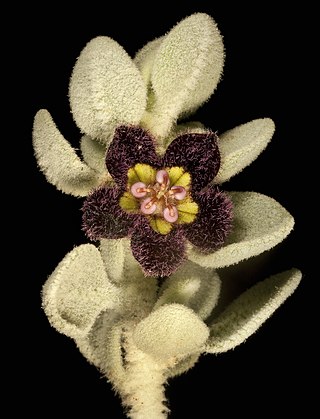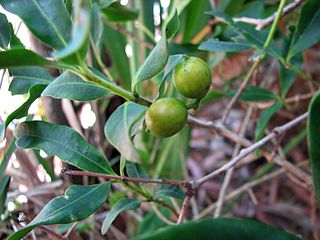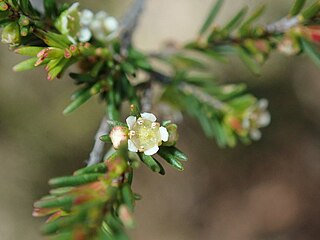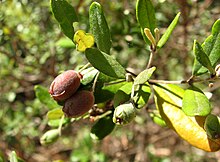
Myrtaceae, the myrtle family, is a family of dicotyledonous plants placed within the order Myrtales. Myrtle, pōhutukawa, bay rum tree, clove, guava, acca (feijoa), allspice, and eucalyptus are some notable members of this group. All species are woody, contain essential oils, and have flower parts in multiples of four or five. The leaves are evergreen, alternate to mostly opposite, simple, and usually entire. The flowers have a base number of five petals, though in several genera, the petals are minute or absent. The stamens are usually very conspicuous, brightly coloured, and numerous.
Fenzlia may refer to three genera of plants, generally treated as synonyms of other genera:

Backhousia is a genus of thirteen currently known species of flowering plants in the family Myrtaceae. All the currently known species are endemic to Australia in the rainforests and seasonally dry forests of Queensland, New South Wales and Western Australia.

Austromyrtus is a genus of shrubs in the myrtle family Myrtaceae. The genus was first described in 1893 by Franz Josef Niedenzu as a section of Myrtus, but in 1941 it was elevated to a genus by Max Burret.

Chamelaucium, also known as waxflower, is a genus of shrubs endemic to south western Western Australia. They belong to the myrtle family Myrtaceae and have flowers similar to those of the tea-trees (Leptospermum). The most well-known species is the Geraldton wax, Chamelaucium uncinatum, which is cultivated widely for its large attractive flowers.

The taxonomy of Banksia integrifolia has a long and complex history, the result of confusion caused by the species' great variability, and similarities with some closely related species. The existence of hybrids between B. integrifolia and related species as well as early attempts to classify the species based on dried specimen material have also contributed to the confusion.

Hypocalymma is a genus of evergreen shrubs in the myrtle family Myrtaceae described as a genus in 1840. The entire genus is endemic to southern Western Australia.

Aphanopetalum is a genus of twining shrubs or vines in the family Aphanopetalaceae which are endemic to Australia.

Anthotroche is a genus of shrubs in the family Solanaceae. The genus is endemic to Western Australia.

Syzygium cormiflorum, commonly known as the bumpy satinash, is a species of Syzygium tree endemic to Queensland in northeastern Australia.
Wendlandia psychotrioides is a species of shrubs or small trees, constituting part of the plant family Rubiaceae.

Lysicarpus is a genus of trees in the family Myrtaceae described as a genus in 1858. It contains a single known species, Lysicarpus angustifolius, endemic to the State of Queensland in Australia. It is known there as the brown hazelwood or budgeroo.

Toechima daemelianum, commonly known as cape tamarind, is an evergreen tree from north-east Queensland in Australia. It grows up to 13 metres high and a trunk which may be up to 20 cm wide.

Alyxia spicata, commonly known as chain fruit, is a sprawling shrub or vine in the family Apocynaceae. It is native to New Guinea and the Australian tropics.

Lithomyrtus is a genus of small trees and shrubs in the myrtle family, Myrtaceae. There are 11 species, native to the tropics of northern Australia and New Guinea:
Myrtella is a genus of plants in the Myrtaceae described as a genus in 1877. It is native to New Guinea and to some islands of the western Pacific.
- Myrtella beccariiF.Muell. - New Guinea, Solomon Islands
- Myrtella bennigseniana(Volkens) Diels - New Guinea, Caroline Islands, Mariana Islands

Ochrosperma is a group of shrubs and small trees in the myrtle family Myrtaceae described as a genus in 1987. The genus is endemic to Australia.
- Ochrosperma adpressumA.R.Bean - Queensland
- Ochrosperma citriodorum(Penfold & J.L.Willis) Trudgen - New South Wales
- Ochrosperma lineare(C.T.White) Trudgen - Queensland, New South Wales
- Ochrosperma obovatumA.R.Bean - Queensland
- Ochrosperma oligomerum(Radlk.) A.R.Bean - New South Wales
- Ochrosperma sulcatumA.R.Bean - Northern Territory

Lithomyrtus retusa is a member of the family Myrtaceae native to Western Australia, the Northern Territory, and Queensland. It was first described in 1834 by Stephan Endlicher as Fenzlia retusa, but in 1999 it was assigned to the genus, Lithomyrtus, to give its currently accepted name, by Neil Snow and Gordon Guymer.

Syzygium forte, commonly known as flaky-barked satinash, white apple or brown satinash, is a tree in the family Myrtaceae native to New Guinea and northern Australia.

Decaisnina brittenii is a species of flowering plant, an epiphytic hemiparasitic plant of the family Loranthaceae native to the Northern Territory, Queensland and northern Western Australia.


















